Supply Chain Management Research: A Case Study of Ha Li Fa Pte
VerifiedAdded on 2020/05/16
|24
|5292
|394
Case Study
AI Summary
This case study examines the supply chain management of Ha Li Fa Pte, a fish ball-producing company. The research explores the company's strategies, including competitive approaches, lean and agile systems, and value propositions. It identifies gaps in its strategic management, such as branding and sustainability, and provides recommendations for improvement. The study covers topics like continuous improvement, brand management, and sustainable supply chain practices. The research highlights the importance of postponement strategies, lean processes, and agile systems in enhancing efficiency, reducing costs, and addressing demand uncertainties. The case study uses both primary and secondary data, including interviews and literature reviews, to analyze the company's current state and suggest ways to optimize its supply chain for increased customer satisfaction and business growth.
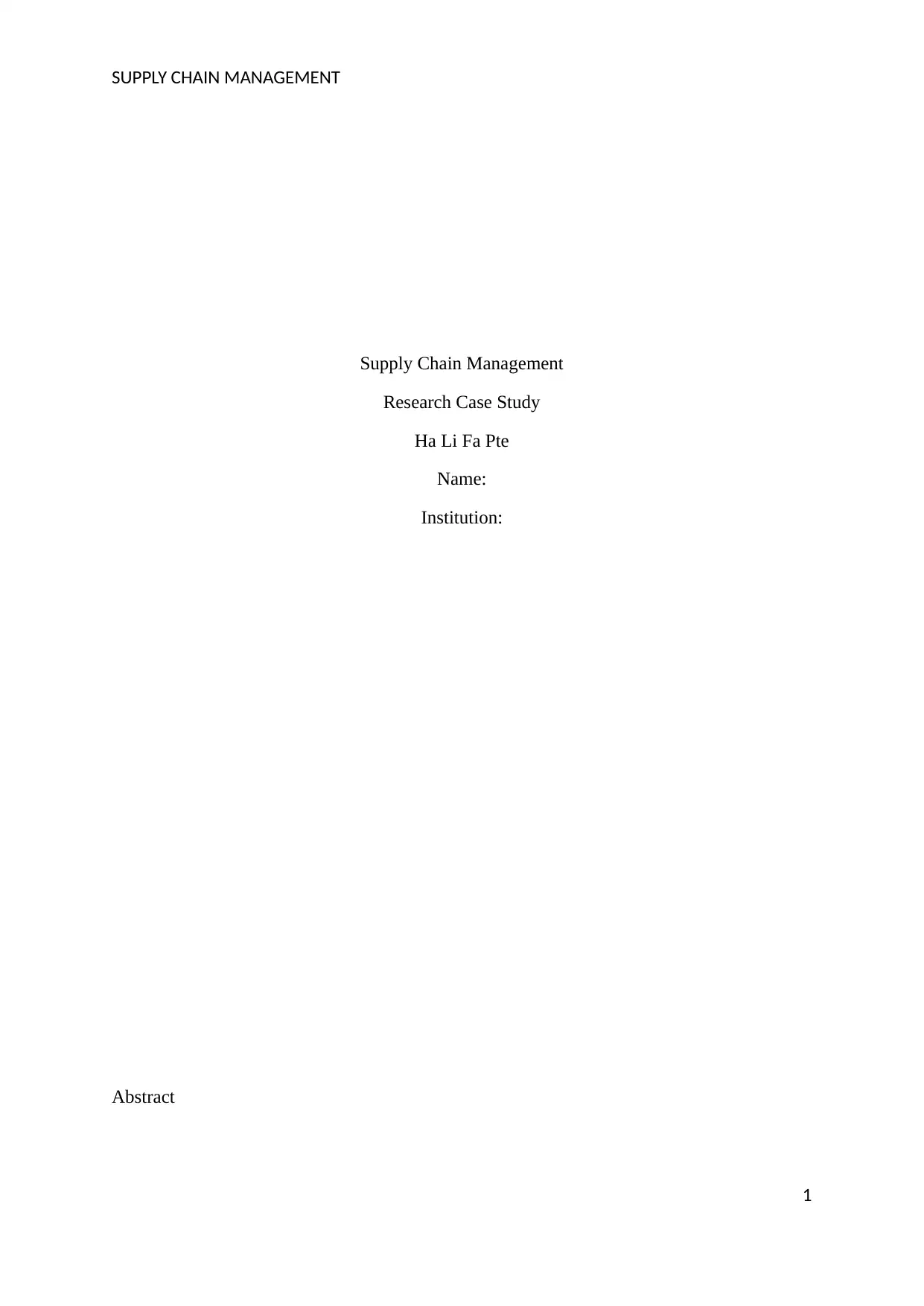
SUPPLY CHAIN MANAGEMENT
Supply Chain Management
Research Case Study
Ha Li Fa Pte
Name:
Institution:
Abstract
1
Supply Chain Management
Research Case Study
Ha Li Fa Pte
Name:
Institution:
Abstract
1
Paraphrase This Document
Need a fresh take? Get an instant paraphrase of this document with our AI Paraphraser
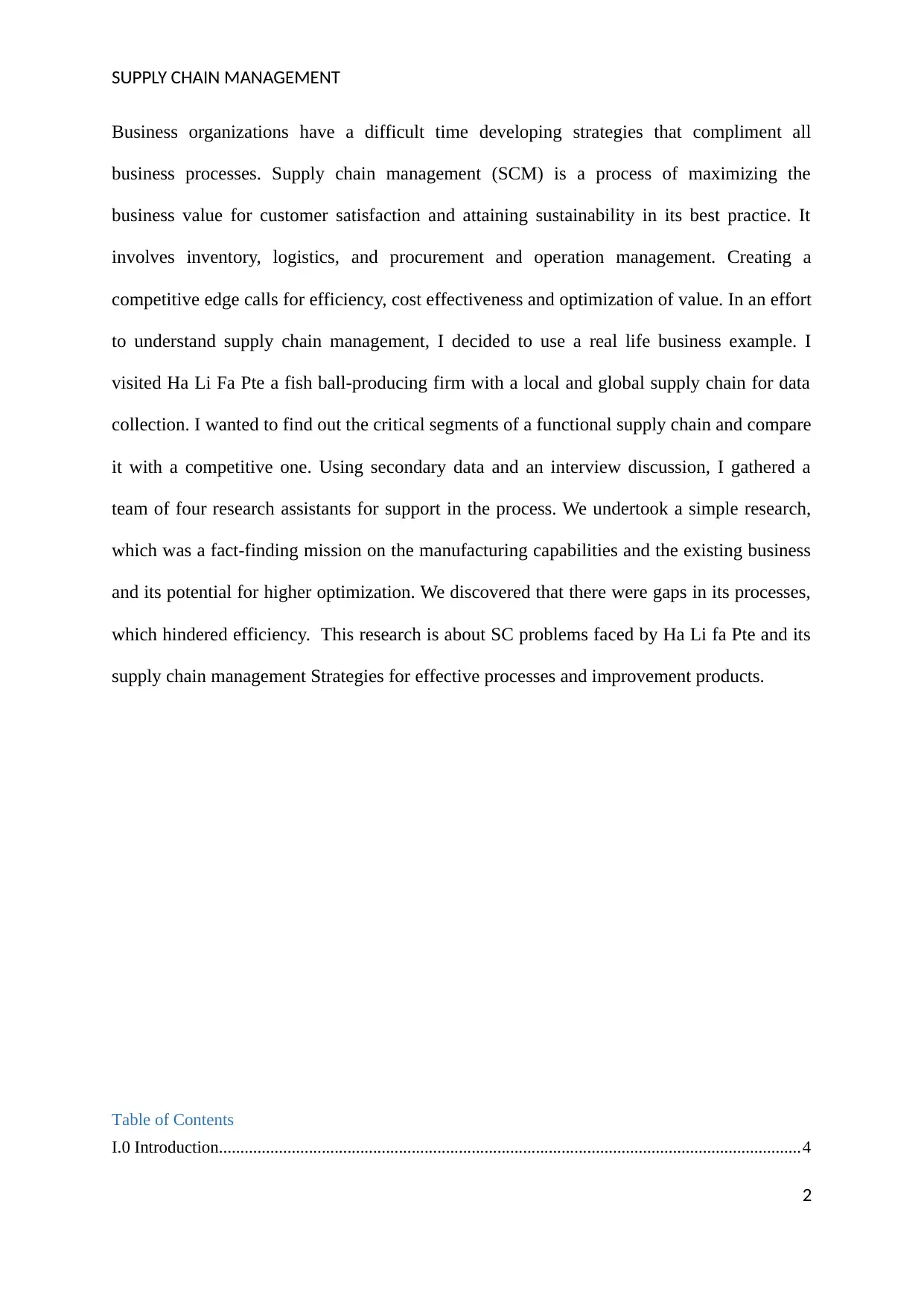
SUPPLY CHAIN MANAGEMENT
Business organizations have a difficult time developing strategies that compliment all
business processes. Supply chain management (SCM) is a process of maximizing the
business value for customer satisfaction and attaining sustainability in its best practice. It
involves inventory, logistics, and procurement and operation management. Creating a
competitive edge calls for efficiency, cost effectiveness and optimization of value. In an effort
to understand supply chain management, I decided to use a real life business example. I
visited Ha Li Fa Pte a fish ball-producing firm with a local and global supply chain for data
collection. I wanted to find out the critical segments of a functional supply chain and compare
it with a competitive one. Using secondary data and an interview discussion, I gathered a
team of four research assistants for support in the process. We undertook a simple research,
which was a fact-finding mission on the manufacturing capabilities and the existing business
and its potential for higher optimization. We discovered that there were gaps in its processes,
which hindered efficiency. This research is about SC problems faced by Ha Li fa Pte and its
supply chain management Strategies for effective processes and improvement products.
Table of Contents
I.0 Introduction........................................................................................................................................4
2
Business organizations have a difficult time developing strategies that compliment all
business processes. Supply chain management (SCM) is a process of maximizing the
business value for customer satisfaction and attaining sustainability in its best practice. It
involves inventory, logistics, and procurement and operation management. Creating a
competitive edge calls for efficiency, cost effectiveness and optimization of value. In an effort
to understand supply chain management, I decided to use a real life business example. I
visited Ha Li Fa Pte a fish ball-producing firm with a local and global supply chain for data
collection. I wanted to find out the critical segments of a functional supply chain and compare
it with a competitive one. Using secondary data and an interview discussion, I gathered a
team of four research assistants for support in the process. We undertook a simple research,
which was a fact-finding mission on the manufacturing capabilities and the existing business
and its potential for higher optimization. We discovered that there were gaps in its processes,
which hindered efficiency. This research is about SC problems faced by Ha Li fa Pte and its
supply chain management Strategies for effective processes and improvement products.
Table of Contents
I.0 Introduction........................................................................................................................................4
2
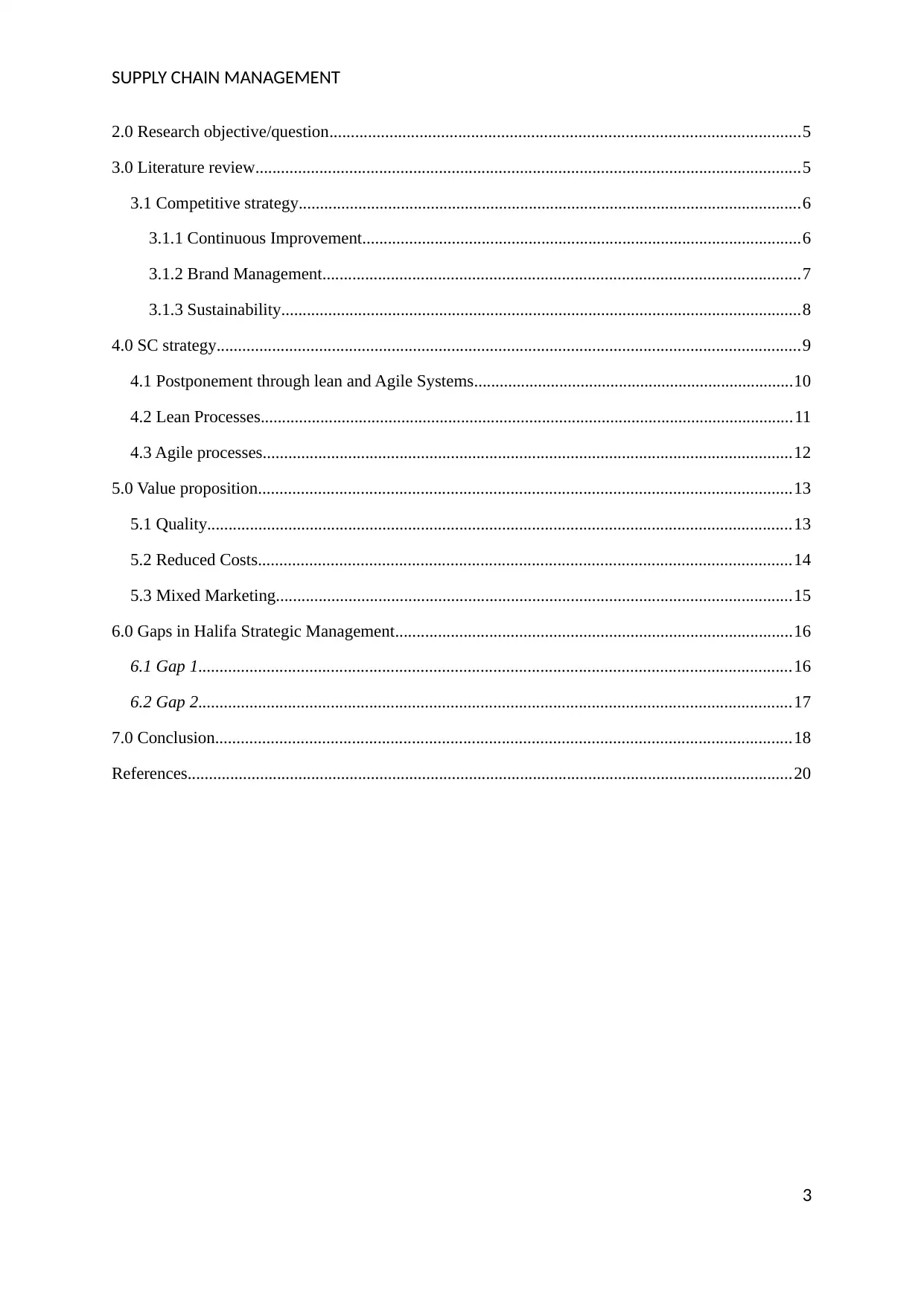
SUPPLY CHAIN MANAGEMENT
2.0 Research objective/question..............................................................................................................5
3.0 Literature review................................................................................................................................5
3.1 Competitive strategy......................................................................................................................6
3.1.1 Continuous Improvement.......................................................................................................6
3.1.2 Brand Management................................................................................................................7
3.1.3 Sustainability..........................................................................................................................8
4.0 SC strategy.........................................................................................................................................9
4.1 Postponement through lean and Agile Systems...........................................................................10
4.2 Lean Processes.............................................................................................................................11
4.3 Agile processes............................................................................................................................12
5.0 Value proposition.............................................................................................................................13
5.1 Quality.........................................................................................................................................13
5.2 Reduced Costs.............................................................................................................................14
5.3 Mixed Marketing.........................................................................................................................15
6.0 Gaps in Halifa Strategic Management.............................................................................................16
6.1 Gap 1...........................................................................................................................................16
6.2 Gap 2...........................................................................................................................................17
7.0 Conclusion.......................................................................................................................................18
References..............................................................................................................................................20
3
2.0 Research objective/question..............................................................................................................5
3.0 Literature review................................................................................................................................5
3.1 Competitive strategy......................................................................................................................6
3.1.1 Continuous Improvement.......................................................................................................6
3.1.2 Brand Management................................................................................................................7
3.1.3 Sustainability..........................................................................................................................8
4.0 SC strategy.........................................................................................................................................9
4.1 Postponement through lean and Agile Systems...........................................................................10
4.2 Lean Processes.............................................................................................................................11
4.3 Agile processes............................................................................................................................12
5.0 Value proposition.............................................................................................................................13
5.1 Quality.........................................................................................................................................13
5.2 Reduced Costs.............................................................................................................................14
5.3 Mixed Marketing.........................................................................................................................15
6.0 Gaps in Halifa Strategic Management.............................................................................................16
6.1 Gap 1...........................................................................................................................................16
6.2 Gap 2...........................................................................................................................................17
7.0 Conclusion.......................................................................................................................................18
References..............................................................................................................................................20
3
⊘ This is a preview!⊘
Do you want full access?
Subscribe today to unlock all pages.

Trusted by 1+ million students worldwide
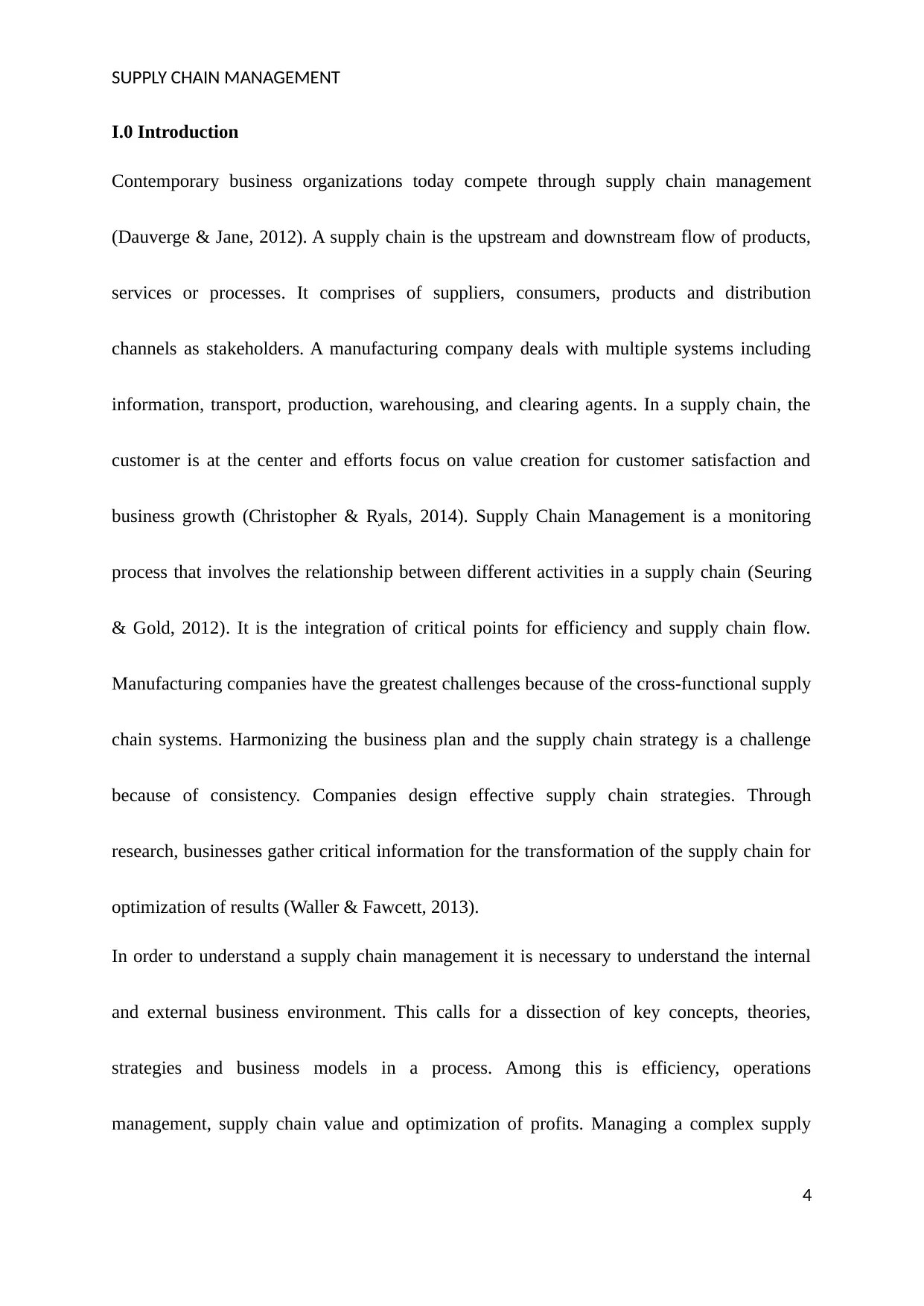
SUPPLY CHAIN MANAGEMENT
I.0 Introduction
Contemporary business organizations today compete through supply chain management
(Dauverge & Jane, 2012). A supply chain is the upstream and downstream flow of products,
services or processes. It comprises of suppliers, consumers, products and distribution
channels as stakeholders. A manufacturing company deals with multiple systems including
information, transport, production, warehousing, and clearing agents. In a supply chain, the
customer is at the center and efforts focus on value creation for customer satisfaction and
business growth (Christopher & Ryals, 2014). Supply Chain Management is a monitoring
process that involves the relationship between different activities in a supply chain (Seuring
& Gold, 2012). It is the integration of critical points for efficiency and supply chain flow.
Manufacturing companies have the greatest challenges because of the cross-functional supply
chain systems. Harmonizing the business plan and the supply chain strategy is a challenge
because of consistency. Companies design effective supply chain strategies. Through
research, businesses gather critical information for the transformation of the supply chain for
optimization of results (Waller & Fawcett, 2013).
In order to understand a supply chain management it is necessary to understand the internal
and external business environment. This calls for a dissection of key concepts, theories,
strategies and business models in a process. Among this is efficiency, operations
management, supply chain value and optimization of profits. Managing a complex supply
4
I.0 Introduction
Contemporary business organizations today compete through supply chain management
(Dauverge & Jane, 2012). A supply chain is the upstream and downstream flow of products,
services or processes. It comprises of suppliers, consumers, products and distribution
channels as stakeholders. A manufacturing company deals with multiple systems including
information, transport, production, warehousing, and clearing agents. In a supply chain, the
customer is at the center and efforts focus on value creation for customer satisfaction and
business growth (Christopher & Ryals, 2014). Supply Chain Management is a monitoring
process that involves the relationship between different activities in a supply chain (Seuring
& Gold, 2012). It is the integration of critical points for efficiency and supply chain flow.
Manufacturing companies have the greatest challenges because of the cross-functional supply
chain systems. Harmonizing the business plan and the supply chain strategy is a challenge
because of consistency. Companies design effective supply chain strategies. Through
research, businesses gather critical information for the transformation of the supply chain for
optimization of results (Waller & Fawcett, 2013).
In order to understand a supply chain management it is necessary to understand the internal
and external business environment. This calls for a dissection of key concepts, theories,
strategies and business models in a process. Among this is efficiency, operations
management, supply chain value and optimization of profits. Managing a complex supply
4
Paraphrase This Document
Need a fresh take? Get an instant paraphrase of this document with our AI Paraphraser
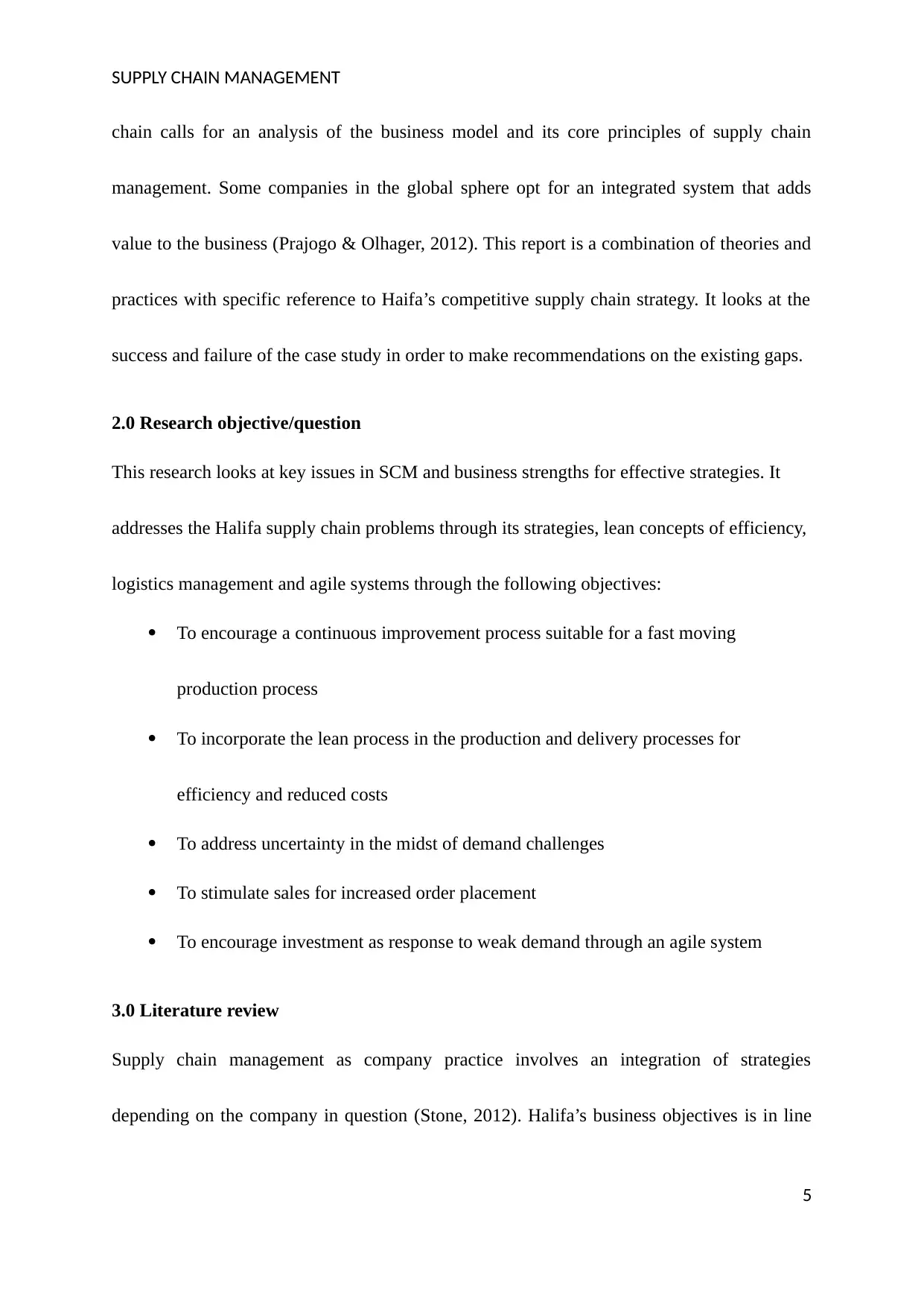
SUPPLY CHAIN MANAGEMENT
chain calls for an analysis of the business model and its core principles of supply chain
management. Some companies in the global sphere opt for an integrated system that adds
value to the business (Prajogo & Olhager, 2012). This report is a combination of theories and
practices with specific reference to Haifa’s competitive supply chain strategy. It looks at the
success and failure of the case study in order to make recommendations on the existing gaps.
2.0 Research objective/question
This research looks at key issues in SCM and business strengths for effective strategies. It
addresses the Halifa supply chain problems through its strategies, lean concepts of efficiency,
logistics management and agile systems through the following objectives:
To encourage a continuous improvement process suitable for a fast moving
production process
To incorporate the lean process in the production and delivery processes for
efficiency and reduced costs
To address uncertainty in the midst of demand challenges
To stimulate sales for increased order placement
To encourage investment as response to weak demand through an agile system
3.0 Literature review
Supply chain management as company practice involves an integration of strategies
depending on the company in question (Stone, 2012). Halifa’s business objectives is in line
5
chain calls for an analysis of the business model and its core principles of supply chain
management. Some companies in the global sphere opt for an integrated system that adds
value to the business (Prajogo & Olhager, 2012). This report is a combination of theories and
practices with specific reference to Haifa’s competitive supply chain strategy. It looks at the
success and failure of the case study in order to make recommendations on the existing gaps.
2.0 Research objective/question
This research looks at key issues in SCM and business strengths for effective strategies. It
addresses the Halifa supply chain problems through its strategies, lean concepts of efficiency,
logistics management and agile systems through the following objectives:
To encourage a continuous improvement process suitable for a fast moving
production process
To incorporate the lean process in the production and delivery processes for
efficiency and reduced costs
To address uncertainty in the midst of demand challenges
To stimulate sales for increased order placement
To encourage investment as response to weak demand through an agile system
3.0 Literature review
Supply chain management as company practice involves an integration of strategies
depending on the company in question (Stone, 2012). Halifa’s business objectives is in line
5
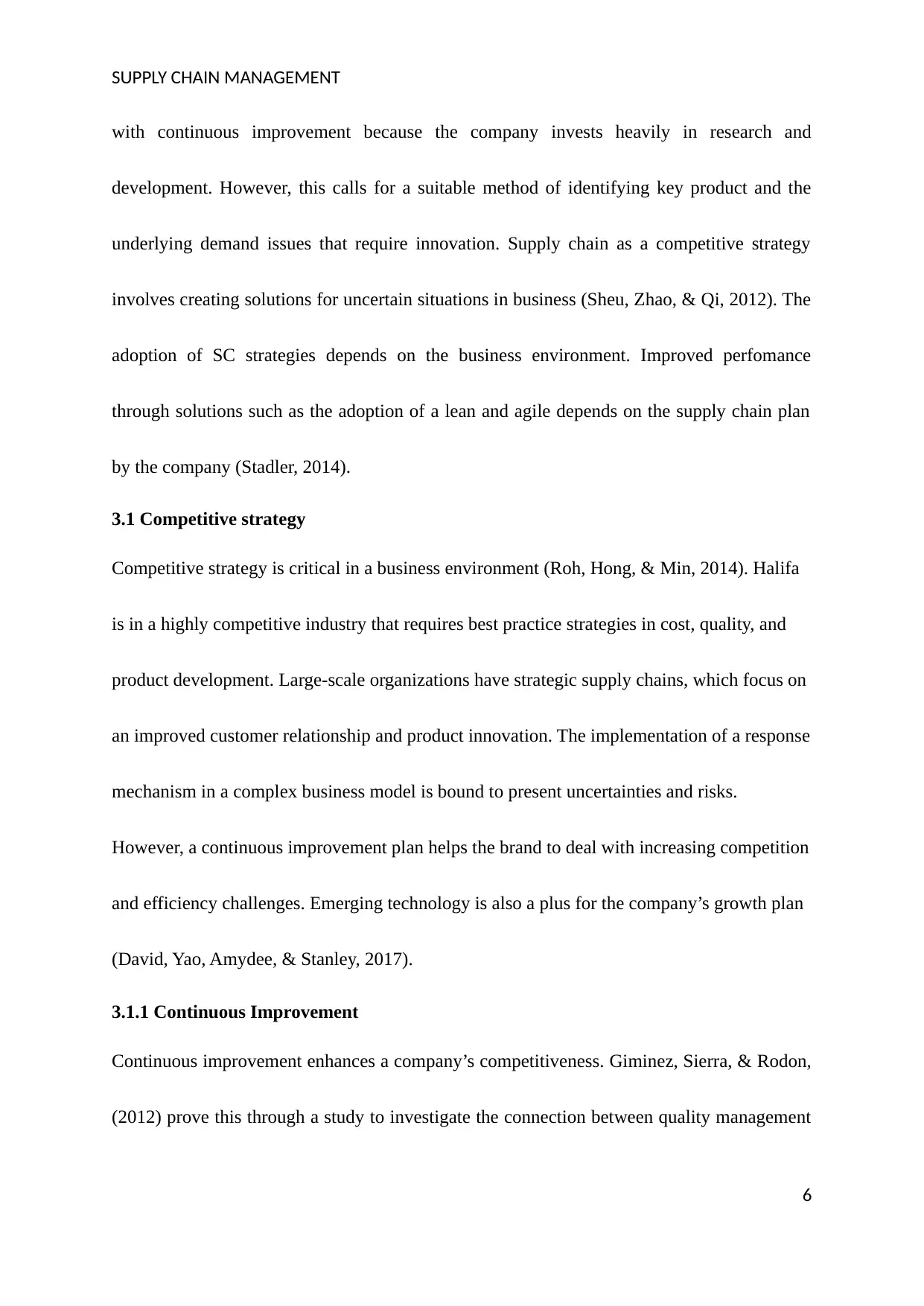
SUPPLY CHAIN MANAGEMENT
with continuous improvement because the company invests heavily in research and
development. However, this calls for a suitable method of identifying key product and the
underlying demand issues that require innovation. Supply chain as a competitive strategy
involves creating solutions for uncertain situations in business (Sheu, Zhao, & Qi, 2012). The
adoption of SC strategies depends on the business environment. Improved perfomance
through solutions such as the adoption of a lean and agile depends on the supply chain plan
by the company (Stadler, 2014).
3.1 Competitive strategy
Competitive strategy is critical in a business environment (Roh, Hong, & Min, 2014). Halifa
is in a highly competitive industry that requires best practice strategies in cost, quality, and
product development. Large-scale organizations have strategic supply chains, which focus on
an improved customer relationship and product innovation. The implementation of a response
mechanism in a complex business model is bound to present uncertainties and risks.
However, a continuous improvement plan helps the brand to deal with increasing competition
and efficiency challenges. Emerging technology is also a plus for the company’s growth plan
(David, Yao, Amydee, & Stanley, 2017).
3.1.1 Continuous Improvement
Continuous improvement enhances a company’s competitiveness. Giminez, Sierra, & Rodon,
(2012) prove this through a study to investigate the connection between quality management
6
with continuous improvement because the company invests heavily in research and
development. However, this calls for a suitable method of identifying key product and the
underlying demand issues that require innovation. Supply chain as a competitive strategy
involves creating solutions for uncertain situations in business (Sheu, Zhao, & Qi, 2012). The
adoption of SC strategies depends on the business environment. Improved perfomance
through solutions such as the adoption of a lean and agile depends on the supply chain plan
by the company (Stadler, 2014).
3.1 Competitive strategy
Competitive strategy is critical in a business environment (Roh, Hong, & Min, 2014). Halifa
is in a highly competitive industry that requires best practice strategies in cost, quality, and
product development. Large-scale organizations have strategic supply chains, which focus on
an improved customer relationship and product innovation. The implementation of a response
mechanism in a complex business model is bound to present uncertainties and risks.
However, a continuous improvement plan helps the brand to deal with increasing competition
and efficiency challenges. Emerging technology is also a plus for the company’s growth plan
(David, Yao, Amydee, & Stanley, 2017).
3.1.1 Continuous Improvement
Continuous improvement enhances a company’s competitiveness. Giminez, Sierra, & Rodon,
(2012) prove this through a study to investigate the connection between quality management
6
⊘ This is a preview!⊘
Do you want full access?
Subscribe today to unlock all pages.

Trusted by 1+ million students worldwide
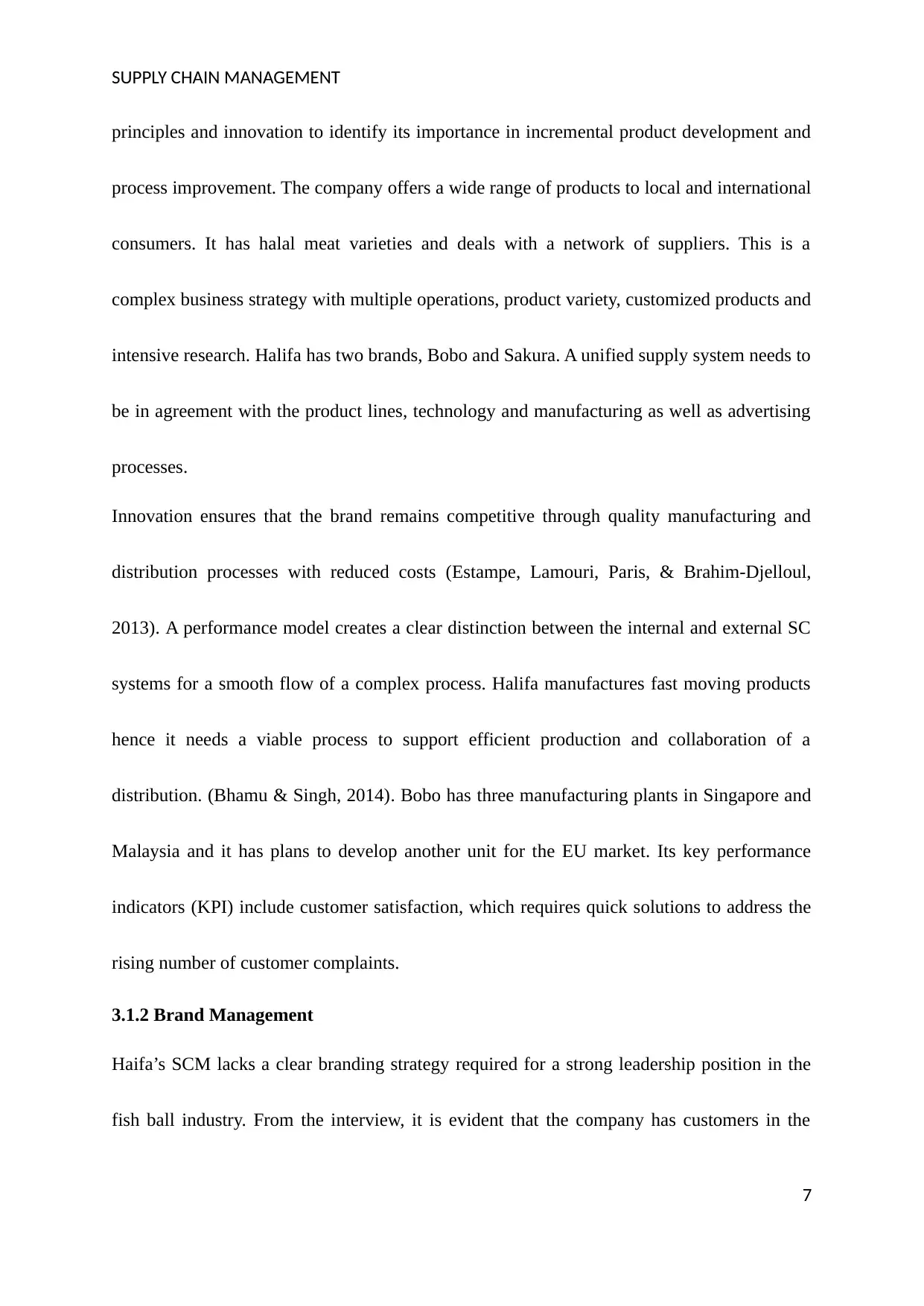
SUPPLY CHAIN MANAGEMENT
principles and innovation to identify its importance in incremental product development and
process improvement. The company offers a wide range of products to local and international
consumers. It has halal meat varieties and deals with a network of suppliers. This is a
complex business strategy with multiple operations, product variety, customized products and
intensive research. Halifa has two brands, Bobo and Sakura. A unified supply system needs to
be in agreement with the product lines, technology and manufacturing as well as advertising
processes.
Innovation ensures that the brand remains competitive through quality manufacturing and
distribution processes with reduced costs (Estampe, Lamouri, Paris, & Brahim-Djelloul,
2013). A performance model creates a clear distinction between the internal and external SC
systems for a smooth flow of a complex process. Halifa manufactures fast moving products
hence it needs a viable process to support efficient production and collaboration of a
distribution. (Bhamu & Singh, 2014). Bobo has three manufacturing plants in Singapore and
Malaysia and it has plans to develop another unit for the EU market. Its key performance
indicators (KPI) include customer satisfaction, which requires quick solutions to address the
rising number of customer complaints.
3.1.2 Brand Management
Haifa’s SCM lacks a clear branding strategy required for a strong leadership position in the
fish ball industry. From the interview, it is evident that the company has customers in the
7
principles and innovation to identify its importance in incremental product development and
process improvement. The company offers a wide range of products to local and international
consumers. It has halal meat varieties and deals with a network of suppliers. This is a
complex business strategy with multiple operations, product variety, customized products and
intensive research. Halifa has two brands, Bobo and Sakura. A unified supply system needs to
be in agreement with the product lines, technology and manufacturing as well as advertising
processes.
Innovation ensures that the brand remains competitive through quality manufacturing and
distribution processes with reduced costs (Estampe, Lamouri, Paris, & Brahim-Djelloul,
2013). A performance model creates a clear distinction between the internal and external SC
systems for a smooth flow of a complex process. Halifa manufactures fast moving products
hence it needs a viable process to support efficient production and collaboration of a
distribution. (Bhamu & Singh, 2014). Bobo has three manufacturing plants in Singapore and
Malaysia and it has plans to develop another unit for the EU market. Its key performance
indicators (KPI) include customer satisfaction, which requires quick solutions to address the
rising number of customer complaints.
3.1.2 Brand Management
Haifa’s SCM lacks a clear branding strategy required for a strong leadership position in the
fish ball industry. From the interview, it is evident that the company has customers in the
7
Paraphrase This Document
Need a fresh take? Get an instant paraphrase of this document with our AI Paraphraser
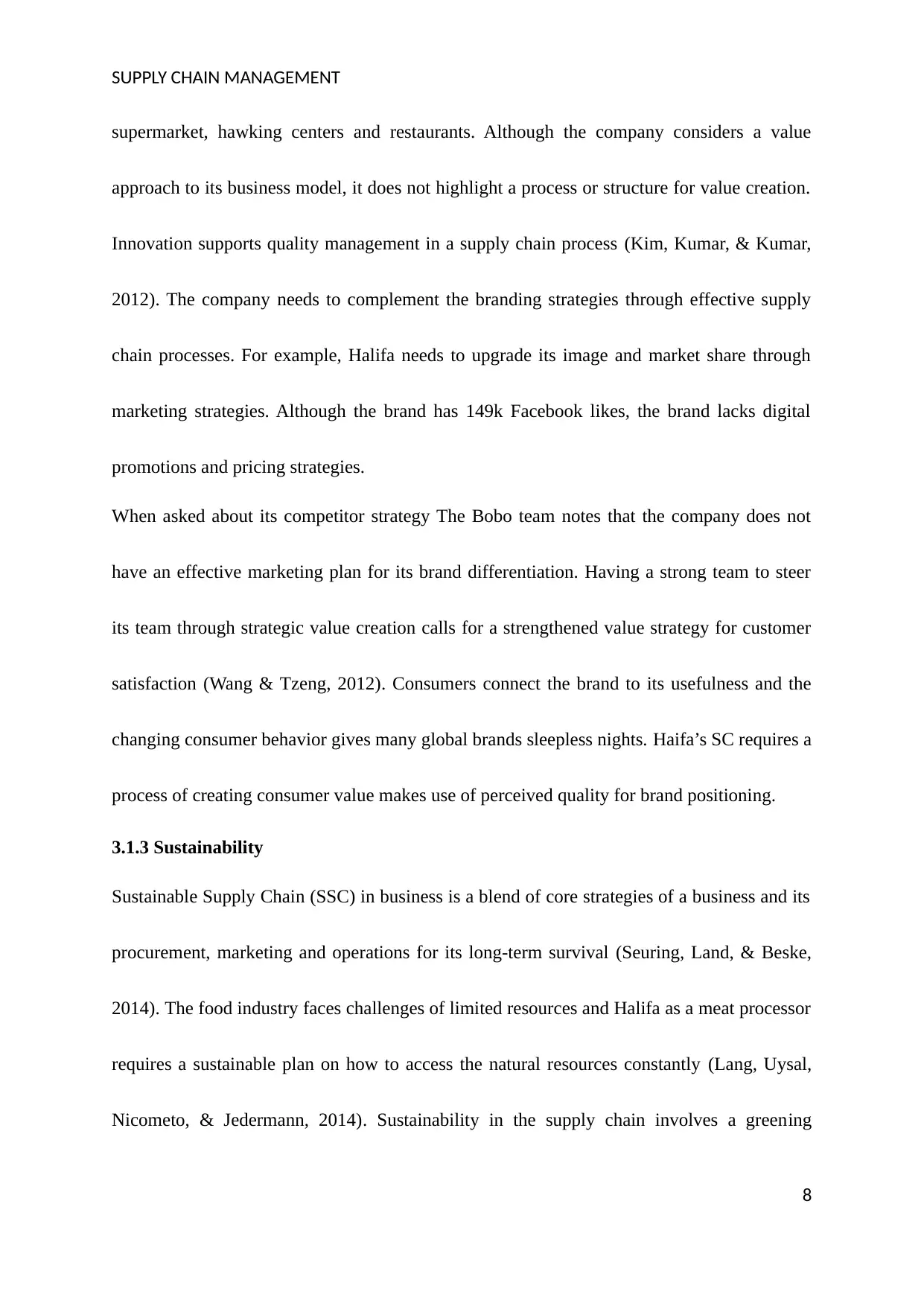
SUPPLY CHAIN MANAGEMENT
supermarket, hawking centers and restaurants. Although the company considers a value
approach to its business model, it does not highlight a process or structure for value creation.
Innovation supports quality management in a supply chain process (Kim, Kumar, & Kumar,
2012). The company needs to complement the branding strategies through effective supply
chain processes. For example, Halifa needs to upgrade its image and market share through
marketing strategies. Although the brand has 149k Facebook likes, the brand lacks digital
promotions and pricing strategies.
When asked about its competitor strategy The Bobo team notes that the company does not
have an effective marketing plan for its brand differentiation. Having a strong team to steer
its team through strategic value creation calls for a strengthened value strategy for customer
satisfaction (Wang & Tzeng, 2012). Consumers connect the brand to its usefulness and the
changing consumer behavior gives many global brands sleepless nights. Haifa’s SC requires a
process of creating consumer value makes use of perceived quality for brand positioning.
3.1.3 Sustainability
Sustainable Supply Chain (SSC) in business is a blend of core strategies of a business and its
procurement, marketing and operations for its long-term survival (Seuring, Land, & Beske,
2014). The food industry faces challenges of limited resources and Halifa as a meat processor
requires a sustainable plan on how to access the natural resources constantly (Lang, Uysal,
Nicometo, & Jedermann, 2014). Sustainability in the supply chain involves a greening
8
supermarket, hawking centers and restaurants. Although the company considers a value
approach to its business model, it does not highlight a process or structure for value creation.
Innovation supports quality management in a supply chain process (Kim, Kumar, & Kumar,
2012). The company needs to complement the branding strategies through effective supply
chain processes. For example, Halifa needs to upgrade its image and market share through
marketing strategies. Although the brand has 149k Facebook likes, the brand lacks digital
promotions and pricing strategies.
When asked about its competitor strategy The Bobo team notes that the company does not
have an effective marketing plan for its brand differentiation. Having a strong team to steer
its team through strategic value creation calls for a strengthened value strategy for customer
satisfaction (Wang & Tzeng, 2012). Consumers connect the brand to its usefulness and the
changing consumer behavior gives many global brands sleepless nights. Haifa’s SC requires a
process of creating consumer value makes use of perceived quality for brand positioning.
3.1.3 Sustainability
Sustainable Supply Chain (SSC) in business is a blend of core strategies of a business and its
procurement, marketing and operations for its long-term survival (Seuring, Land, & Beske,
2014). The food industry faces challenges of limited resources and Halifa as a meat processor
requires a sustainable plan on how to access the natural resources constantly (Lang, Uysal,
Nicometo, & Jedermann, 2014). Sustainability in the supply chain involves a greening
8
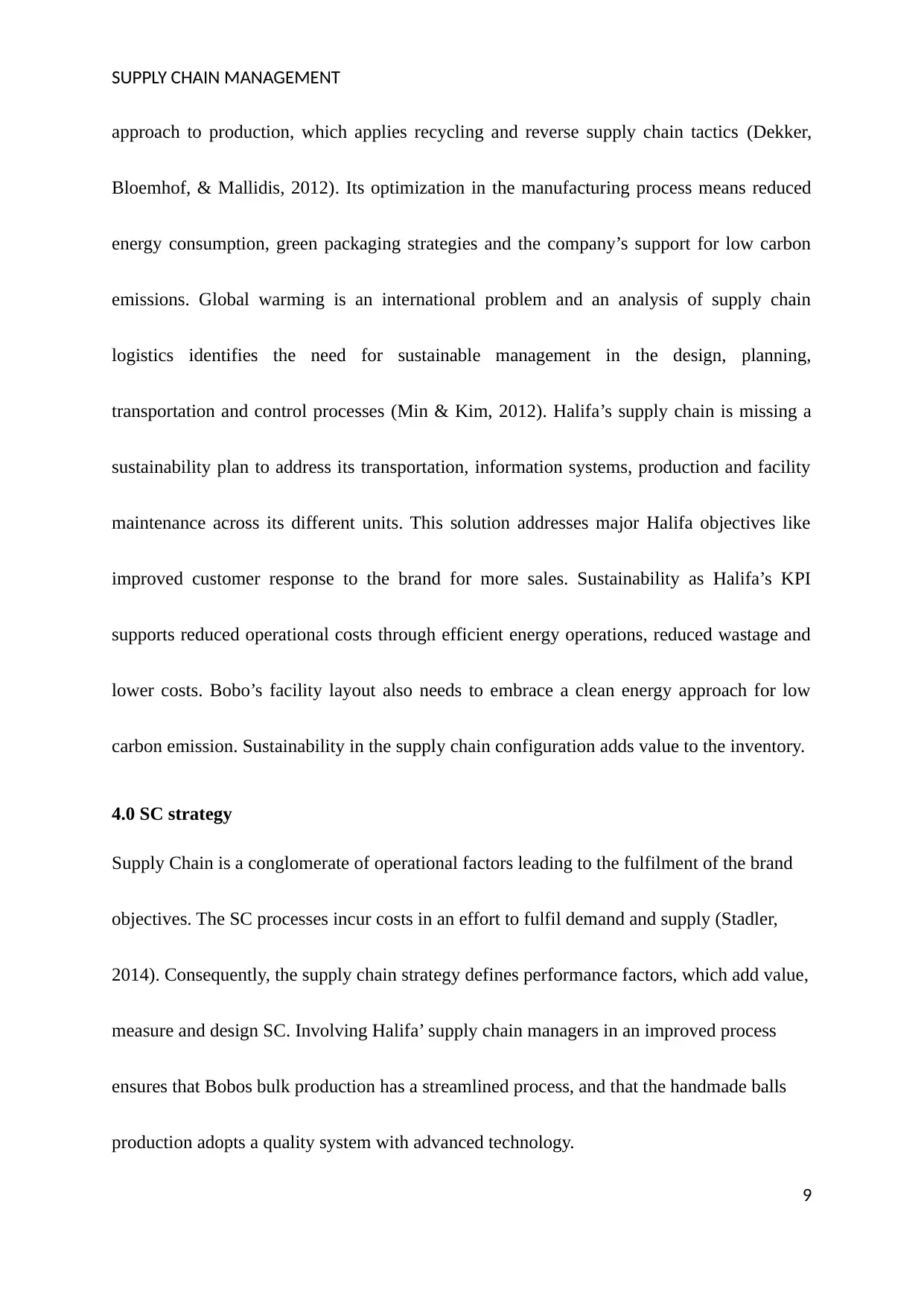
SUPPLY CHAIN MANAGEMENT
approach to production, which applies recycling and reverse supply chain tactics (Dekker,
Bloemhof, & Mallidis, 2012). Its optimization in the manufacturing process means reduced
energy consumption, green packaging strategies and the company’s support for low carbon
emissions. Global warming is an international problem and an analysis of supply chain
logistics identifies the need for sustainable management in the design, planning,
transportation and control processes (Min & Kim, 2012). Halifa’s supply chain is missing a
sustainability plan to address its transportation, information systems, production and facility
maintenance across its different units. This solution addresses major Halifa objectives like
improved customer response to the brand for more sales. Sustainability as Halifa’s KPI
supports reduced operational costs through efficient energy operations, reduced wastage and
lower costs. Bobo’s facility layout also needs to embrace a clean energy approach for low
carbon emission. Sustainability in the supply chain configuration adds value to the inventory.
4.0 SC strategy
Supply Chain is a conglomerate of operational factors leading to the fulfilment of the brand
objectives. The SC processes incur costs in an effort to fulfil demand and supply (Stadler,
2014). Consequently, the supply chain strategy defines performance factors, which add value,
measure and design SC. Involving Halifa’ supply chain managers in an improved process
ensures that Bobos bulk production has a streamlined process, and that the handmade balls
production adopts a quality system with advanced technology.
9
approach to production, which applies recycling and reverse supply chain tactics (Dekker,
Bloemhof, & Mallidis, 2012). Its optimization in the manufacturing process means reduced
energy consumption, green packaging strategies and the company’s support for low carbon
emissions. Global warming is an international problem and an analysis of supply chain
logistics identifies the need for sustainable management in the design, planning,
transportation and control processes (Min & Kim, 2012). Halifa’s supply chain is missing a
sustainability plan to address its transportation, information systems, production and facility
maintenance across its different units. This solution addresses major Halifa objectives like
improved customer response to the brand for more sales. Sustainability as Halifa’s KPI
supports reduced operational costs through efficient energy operations, reduced wastage and
lower costs. Bobo’s facility layout also needs to embrace a clean energy approach for low
carbon emission. Sustainability in the supply chain configuration adds value to the inventory.
4.0 SC strategy
Supply Chain is a conglomerate of operational factors leading to the fulfilment of the brand
objectives. The SC processes incur costs in an effort to fulfil demand and supply (Stadler,
2014). Consequently, the supply chain strategy defines performance factors, which add value,
measure and design SC. Involving Halifa’ supply chain managers in an improved process
ensures that Bobos bulk production has a streamlined process, and that the handmade balls
production adopts a quality system with advanced technology.
9
⊘ This is a preview!⊘
Do you want full access?
Subscribe today to unlock all pages.

Trusted by 1+ million students worldwide
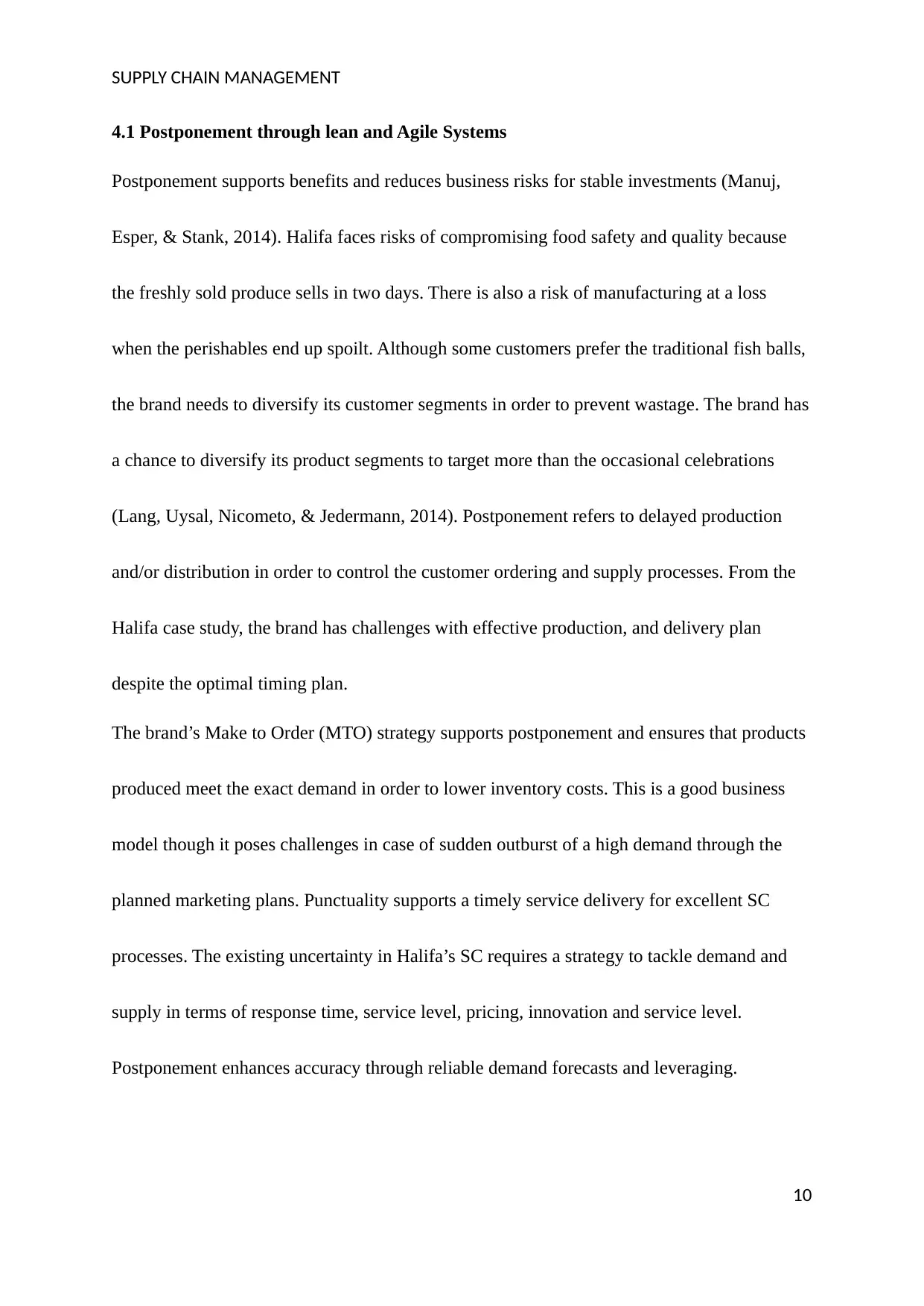
SUPPLY CHAIN MANAGEMENT
4.1 Postponement through lean and Agile Systems
Postponement supports benefits and reduces business risks for stable investments (Manuj,
Esper, & Stank, 2014). Halifa faces risks of compromising food safety and quality because
the freshly sold produce sells in two days. There is also a risk of manufacturing at a loss
when the perishables end up spoilt. Although some customers prefer the traditional fish balls,
the brand needs to diversify its customer segments in order to prevent wastage. The brand has
a chance to diversify its product segments to target more than the occasional celebrations
(Lang, Uysal, Nicometo, & Jedermann, 2014). Postponement refers to delayed production
and/or distribution in order to control the customer ordering and supply processes. From the
Halifa case study, the brand has challenges with effective production, and delivery plan
despite the optimal timing plan.
The brand’s Make to Order (MTO) strategy supports postponement and ensures that products
produced meet the exact demand in order to lower inventory costs. This is a good business
model though it poses challenges in case of sudden outburst of a high demand through the
planned marketing plans. Punctuality supports a timely service delivery for excellent SC
processes. The existing uncertainty in Halifa’s SC requires a strategy to tackle demand and
supply in terms of response time, service level, pricing, innovation and service level.
Postponement enhances accuracy through reliable demand forecasts and leveraging.
10
4.1 Postponement through lean and Agile Systems
Postponement supports benefits and reduces business risks for stable investments (Manuj,
Esper, & Stank, 2014). Halifa faces risks of compromising food safety and quality because
the freshly sold produce sells in two days. There is also a risk of manufacturing at a loss
when the perishables end up spoilt. Although some customers prefer the traditional fish balls,
the brand needs to diversify its customer segments in order to prevent wastage. The brand has
a chance to diversify its product segments to target more than the occasional celebrations
(Lang, Uysal, Nicometo, & Jedermann, 2014). Postponement refers to delayed production
and/or distribution in order to control the customer ordering and supply processes. From the
Halifa case study, the brand has challenges with effective production, and delivery plan
despite the optimal timing plan.
The brand’s Make to Order (MTO) strategy supports postponement and ensures that products
produced meet the exact demand in order to lower inventory costs. This is a good business
model though it poses challenges in case of sudden outburst of a high demand through the
planned marketing plans. Punctuality supports a timely service delivery for excellent SC
processes. The existing uncertainty in Halifa’s SC requires a strategy to tackle demand and
supply in terms of response time, service level, pricing, innovation and service level.
Postponement enhances accuracy through reliable demand forecasts and leveraging.
10
Paraphrase This Document
Need a fresh take? Get an instant paraphrase of this document with our AI Paraphraser
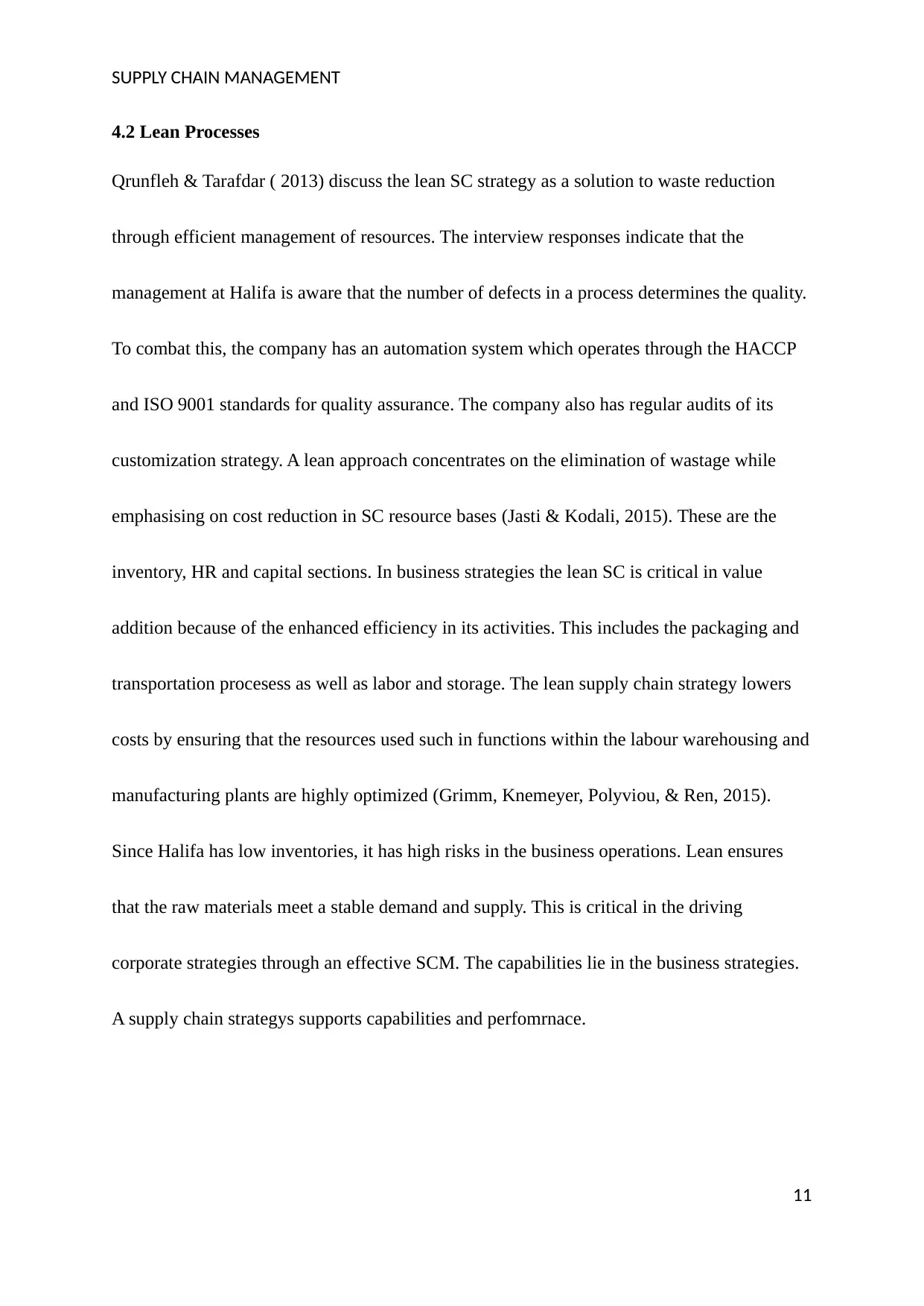
SUPPLY CHAIN MANAGEMENT
4.2 Lean Processes
Qrunfleh & Tarafdar ( 2013) discuss the lean SC strategy as a solution to waste reduction
through efficient management of resources. The interview responses indicate that the
management at Halifa is aware that the number of defects in a process determines the quality.
To combat this, the company has an automation system which operates through the HACCP
and ISO 9001 standards for quality assurance. The company also has regular audits of its
customization strategy. A lean approach concentrates on the elimination of wastage while
emphasising on cost reduction in SC resource bases (Jasti & Kodali, 2015). These are the
inventory, HR and capital sections. In business strategies the lean SC is critical in value
addition because of the enhanced efficiency in its activities. This includes the packaging and
transportation procesess as well as labor and storage. The lean supply chain strategy lowers
costs by ensuring that the resources used such in functions within the labour warehousing and
manufacturing plants are highly optimized (Grimm, Knemeyer, Polyviou, & Ren, 2015).
Since Halifa has low inventories, it has high risks in the business operations. Lean ensures
that the raw materials meet a stable demand and supply. This is critical in the driving
corporate strategies through an effective SCM. The capabilities lie in the business strategies.
A supply chain strategys supports capabilities and perfomrnace.
11
4.2 Lean Processes
Qrunfleh & Tarafdar ( 2013) discuss the lean SC strategy as a solution to waste reduction
through efficient management of resources. The interview responses indicate that the
management at Halifa is aware that the number of defects in a process determines the quality.
To combat this, the company has an automation system which operates through the HACCP
and ISO 9001 standards for quality assurance. The company also has regular audits of its
customization strategy. A lean approach concentrates on the elimination of wastage while
emphasising on cost reduction in SC resource bases (Jasti & Kodali, 2015). These are the
inventory, HR and capital sections. In business strategies the lean SC is critical in value
addition because of the enhanced efficiency in its activities. This includes the packaging and
transportation procesess as well as labor and storage. The lean supply chain strategy lowers
costs by ensuring that the resources used such in functions within the labour warehousing and
manufacturing plants are highly optimized (Grimm, Knemeyer, Polyviou, & Ren, 2015).
Since Halifa has low inventories, it has high risks in the business operations. Lean ensures
that the raw materials meet a stable demand and supply. This is critical in the driving
corporate strategies through an effective SCM. The capabilities lie in the business strategies.
A supply chain strategys supports capabilities and perfomrnace.
11
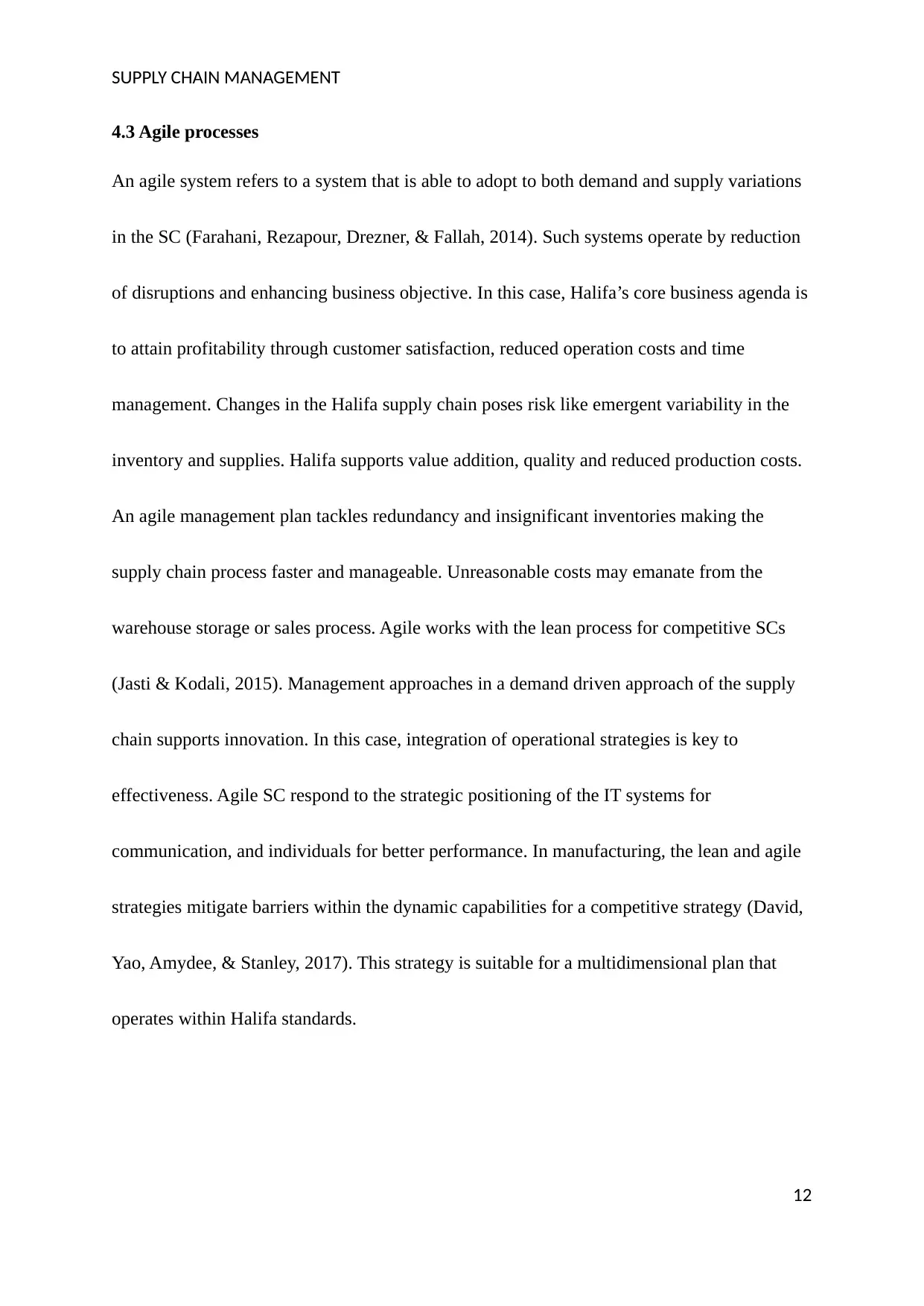
SUPPLY CHAIN MANAGEMENT
4.3 Agile processes
An agile system refers to a system that is able to adopt to both demand and supply variations
in the SC (Farahani, Rezapour, Drezner, & Fallah, 2014). Such systems operate by reduction
of disruptions and enhancing business objective. In this case, Halifa’s core business agenda is
to attain profitability through customer satisfaction, reduced operation costs and time
management. Changes in the Halifa supply chain poses risk like emergent variability in the
inventory and supplies. Halifa supports value addition, quality and reduced production costs.
An agile management plan tackles redundancy and insignificant inventories making the
supply chain process faster and manageable. Unreasonable costs may emanate from the
warehouse storage or sales process. Agile works with the lean process for competitive SCs
(Jasti & Kodali, 2015). Management approaches in a demand driven approach of the supply
chain supports innovation. In this case, integration of operational strategies is key to
effectiveness. Agile SC respond to the strategic positioning of the IT systems for
communication, and individuals for better performance. In manufacturing, the lean and agile
strategies mitigate barriers within the dynamic capabilities for a competitive strategy (David,
Yao, Amydee, & Stanley, 2017). This strategy is suitable for a multidimensional plan that
operates within Halifa standards.
12
4.3 Agile processes
An agile system refers to a system that is able to adopt to both demand and supply variations
in the SC (Farahani, Rezapour, Drezner, & Fallah, 2014). Such systems operate by reduction
of disruptions and enhancing business objective. In this case, Halifa’s core business agenda is
to attain profitability through customer satisfaction, reduced operation costs and time
management. Changes in the Halifa supply chain poses risk like emergent variability in the
inventory and supplies. Halifa supports value addition, quality and reduced production costs.
An agile management plan tackles redundancy and insignificant inventories making the
supply chain process faster and manageable. Unreasonable costs may emanate from the
warehouse storage or sales process. Agile works with the lean process for competitive SCs
(Jasti & Kodali, 2015). Management approaches in a demand driven approach of the supply
chain supports innovation. In this case, integration of operational strategies is key to
effectiveness. Agile SC respond to the strategic positioning of the IT systems for
communication, and individuals for better performance. In manufacturing, the lean and agile
strategies mitigate barriers within the dynamic capabilities for a competitive strategy (David,
Yao, Amydee, & Stanley, 2017). This strategy is suitable for a multidimensional plan that
operates within Halifa standards.
12
⊘ This is a preview!⊘
Do you want full access?
Subscribe today to unlock all pages.

Trusted by 1+ million students worldwide
1 out of 24
Related Documents
Your All-in-One AI-Powered Toolkit for Academic Success.
+13062052269
info@desklib.com
Available 24*7 on WhatsApp / Email
![[object Object]](/_next/static/media/star-bottom.7253800d.svg)
Unlock your academic potential
Copyright © 2020–2025 A2Z Services. All Rights Reserved. Developed and managed by ZUCOL.





